This article will help you to research a soldier who served in the First World War by using contemporary newspapers which often contain vital information that cannot be found elsewhere. I have also written other guides to help you research soldiers who served during the war:
Using First World War Newspaper Reports to Research Soldiers
Beginning your research into First World War soldiers can be a difficult task but a search of a local newspaper can bring excellent results. This is especially the case when a soldier was awarded a gallantry medal or became a casualty, whether being killed in action, wounded, reported missing, ill or taken prisoner. The best search results are for soldiers who were killed in action and reports of their death can usually be found within a month of a telegram or letter being sent to their next of kin. However, if a soldier was initially reported missing, check casualty lists and the army register of soldiers’ effects, then there will often be a second report confirming their capture or death.
Depending on where a soldier lived there may be multiple newspapers to check and there is always the possibility of a photograph of the soldier appearing. Below is an extract from the Bradford Weekly Telegraph published on 19 April 1918. Nearly a hundred photographs of local soldiers appeared on this page alone, with most of the casualties being in consequence of the German Spring Offensive which opened on 21 March 1918. Family photographs were often published as well, usually showing multiple sons who had enlisted. These were either group shots or individual photographs published together. A typical example is shown at the bottom of the page.
Though some newspapers have been digitised and are available to view online for a fee, the vast majority are only accessible at local libraries and the British Library. I would suggest starting your research by searching the digitized newspaper records on FindmyPast. As of May 2020, 36.9 million newspaper pages have been digitized and thousands more get added every month. They include the War Office Weekly Casualty Lists from August 1917 to December 1918 which is an excellent resource. If you are searching for a photograph of an officer who was killed, then I would recommend looking at The Illustrated London News, The Tatler, The Sphere and Illustrated Sporting and Dramatic News. These papers have been digitized and can be searched on FindmyPast which has a free trial period by clicking on the banner below.
Searching the British Library’s Newspaper Catalogue
The easiest way to find a list of local newspapers is to search the British Library’s catalogue. Then search for the city, town or county etc. you’re trying to find newspaper coverage for. After you search, click on “Newspaper” which can be found underneath Material Type on the left-hand side. This will remove all results which aren’t newspapers. Once you click on a newspaper header, click on details and there will usually be one or more blue hyperlinks, next to subject. These hyperlinks will enable you to search by county or city. For example, the subjects for The Manchester District Advertiser are “Greater Manchester (England) – Newspapers” and “Manchester (England) – Newspapers”. Clicking on the subject hyperlinks will display all newspapers which have been tagged for these areas. The newspapers listed will either be available as microfilm which can be ordered on the day or in volumes which take forty-eight hours to arrive. Occasionally, a newspaper may be in such poor condition that it cannot be sent.
Tips for Searching Newspapers
- When you search, bear in mind that initials were often used instead of full names and I’d also recommend searching addresses.
- Often, when one family member became a casualty other information was provided in the newspaper account regarding additional family members who were serving.
- The technology used to search digitized newspapers isn’t perfect and can often misread words and numbers. Therefore, try a combination of searches e.g. just their regimental number, regimental number and surname etc.
- The information printed in newspapers wasn’t always accurate, so always try to cross-reference any facts where possible.
Examples of Successful First World War Newspaper Searches
Below is a report I found for a client researching a relative who was killed in the First World War. Not only does the account provide extensive information as to how Maxwell Frank, a Lance-Corporal in the 10th Battalion The Prince of Wales’s Own (West Yorkshire Regiment), was killed and buried, but there was also the added bonus of a photograph. The Battalion’s war diary recorded the unit was in the trenches near Hébuterne on 15 September where there was “Considerable shelling of trenches and of Hebuterne”. There was no mention of any casualties in the daily entry which is often encountered for other ranks. Maxwell Frank is buried in the Hebuterne Military Cemetery.
Harrogate Herald and List of Visitors, Wednesday, October 4, 1916
Lance-Corporal M. Frank, son of Mr and Mrs K. Frank, 15 Duchy Grove, Harrogate, who was killed in France on September 15th, was 20 years of age and joined the army in March 1914. He sailed for the Dardanelles on the 15th September, 1914. He was afterwards in Egypt. He went to France in May. Previous to enlisting he worked with his father, who is also serving in France, and his only brother is in training at Lowestoft. Mrs Frank has received the following letters:
Dear Mrs Frank,
I am writing to condole with you for the loss of your son, Lance- Corporal Frank. I got to know him very well as one does those who share one’s dangers. He made many friends. He was the sort of cheerful boy who always does. He was always the man who helped others, and tried his hardest to make them happy. Apart from that he was a thoroughly good and trustworthy soldier, and had been marked by his company commander for early promotion. We all feel his loss deeply. I was present at his funeral. We buried him in a beautiful cemetery just west of—–. While the simple service was being read, the guns of the battery just behind us were roaring a fit requiem for a soldier. A cross is being erected by the regiment at the head of his grave. It may be a comfort to you to know that death was instantaneous by the bursting of a shell. Any particulars that I have left out that you would like to know I would be very pleased to give you.
Yours sincerely,
W. Y. Hartnell, Second Lieutenant
Dear Madam,
I regret to inform you that your son, Lance-Corporal M. Frank passed away on the 15 instant. He was on duty in the front line trench, and died without pain, his death being instantaneous, the result of a shell bursting close to him. It will be a comfort to you to know that he was buried quite respectably in a village behind the line, the name of which I will tell you later. Your boy made many friends in the company, and we tender to you our heartfelt sympathy in your great loss. I have got his cap badge and photos, and will forward them to you at the earliest opportunity.
Yours respectfully,
W. T. Epton C.S.M.
The photographs below were published in The Birkenhead News on 17 March 1915 and show men of the Rule family serving in the armed forces. This was another successful search for a client. The photographs were taken from a microfilm at the British Library which is why they are such poor quality.
Stanley Rule was killed in action on 19 February 1915 serving with the 1st Battalion The Cheshire Regiment and is commemorated on the Ypres (Menin Gate) Memorial. Benjamin Rule was killed in action on 25 July 1915 while serving with the 4th Battalion South Wales Borderers at Gallipoli and is commemorated on the Helles Memorial. Both deaths were reported in the newspaper. Under the headings “Seven Brothers Rule” and “Birkenhead Family’s Splendid Record” the following was reported:
Mr. and Mrs. Rule, of 81, Cleveland Street, Birkenhead, have the honour of having no less than seven sons who are at the present moment serving their King and country. Mr Rule, unfortunately, is an invalid but derives great happiness by the fact that he is so splendidly represented by his offspring.
Private Richard H. Rule has served for 17 years in the Royal Engineers and is now with his regiment in France. Private David Rule was in the Royal Horse Artillery, and served seven years in India. He is now in the Royal Engineers stationed in London. Private John Rule is in the 15th Hussars, and went through the South African War. He was a Birkenhead postman when recalled to the colours.
Private William Rule is a member of the R.A.M.C., now at Aldershot. He is an employee of Messrs. Cammell-Laird. Private Albert Rule has joined the Naval Brigade at Greenock, where he has been employed. Private Stanley Rule is attached to the 3rd Cheshire Regiment. Private Benjamin Rule is in the 8th Cheshires, stationed at Swindon.
In addition to these Mr. and Mrs. Rule have a son in Australia who has joined one of the Colonial defence forces, George, who formerly served in the 8th Hussars, whilst their son Thomas, now employed by Messrs, Cammell, Laird, and Co. formerly served in the Cheshires (the Greys), and is only prevented from rejoining by the loss of a finger on his right hand.



